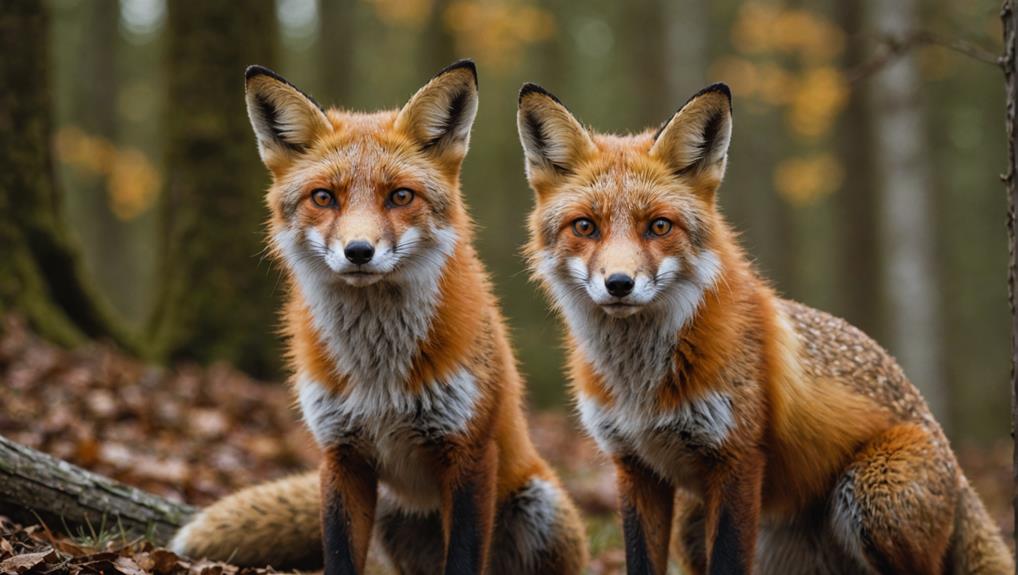You might be surprised to know that only about 10% of fox species exhibit noticeable sexual dimorphism in their coat colors. This makes it challenging to determine the sex of a fox based solely on its coloration. In fact, juvenile males may display slightly darker fur variations, but this characteristic is not a reliable indicator of sex. As you explore the world of foxes, you’ll discover that seasonal changes and individual variations further complicate visual distinctions. So, what other factors come into play when identifying male and female foxes, and how can you accurately determine their sex?
Contents
- 1 Sex Differences in Foxes
- 2 Identifying Male and Female Foxes
- 3 Skull Morphology and Sex
- 4 Color Traits and Sex Differences
- 5 Diet and Habitat Adaptations
- 6 Behavioral Cues in Foxes
- 7 Physical Characteristics of Foxes
- 8 Seasonal Changes and Sex
- 9 Accurate Sex Determination Methods
- 10 Frequently Asked Questions
- 11 Final Thoughts
Sex Differences in Foxes
While observing foxes in their natural habitat, you may notice subtle differences between males and females. These distinctions, known as sexual dimorphism, can be challenging to identify, especially when it comes to coloration. Male and female red foxes generally have similar fur colors, making visual sex differentiation tricky. However, there are some characteristics that can help you identify the sex.
Foxes, like the Arctic fox, have adapted to various environments, which can affect their physical characteristics. Additionally, their diverse habitats may influence the development of certain traits.
Adult males tend to have a thicker neck and body mass, which is, on average, 17% greater than that of females. Their head shape is also broader, with a thicker muzzle structure compared to females, who often have narrower heads.
Another distinguishing feature is the ear positioning, with males forming a W-shape and females a V-shape when observed in the field. These differences can be subtle, and seasonal changes in fur can mask them. But by paying attention to these traits, you can increase your chances of identifying the sex of a fox.
Identifying Male and Female Foxes
You’ve likely noticed that telling male and female foxes apart can be a challenge, especially when it comes to coloration. This is because male and female red foxes exhibit minimal sexual dimorphism, making visual sex identification tricky based solely on color traits.
While males are typically larger with broader heads and thicker necks compared to females, these physical differences may only manifest as slight variations in fur patterns under certain lighting conditions. Foxes are also known for their adaptability, as seen in the Arctic Fox’s seasonal camouflage, which can further complicate identification.
Additionally, the Fennec Fox’s large ears serve as a unique characteristic, but don’t indicate sex. During the breeding season, you might notice that males display darker fur, while females appear sleeker with a lighter hue due to their nursing roles.
Observers can look for specific seasonal indicators, such as the cream-colored scrotum in males or prominent teats in nursing females, to aid in identification.
Remember, variability in coat color, like the appearance of golden cubs, doesn’t reliably indicate sex and can mislead attempts at identification.
Skull Morphology and Sex

By examining skull morphology, you can significantly improve your accuracy in differentiating between male and female foxes, with success rates reaching 70-90% based on key metrics such as total skull length, zygomatic width, and mastoid width. This is because male foxes tend to exhibit larger skull dimensions compared to females, a characteristic known as sexual dimorphism.
Foxes display diverse habitat preferences, with significant adaptations that allow them to thrive in various ecosystems unique adaptations, and understanding these adaptations can provide valuable insights into their ecological roles.
However, things get a bit tricky when dealing with young male foxes, as they often display less sexual dimorphism at a young age, making immediate identification more challenging.
The presence and development of the sagittal crest also vary with age, with younger males often lacking prominent features. This is why age-related analysis is crucial for accurate sex identification.
Interestingly, age-related changes in skull structure tend to enhance sexual dimorphism in males after they reach six months of age, making their identification easier. Research suggests that these differences in skull morphology reflect dietary and niche separation between males and females, influencing their ecological roles within their environments.
Color Traits and Sex Differences
Get ready to dive into the fascinating realm of color traits in foxes, where the lines between male and female blur.
As you explore the world of red foxes, you’ll discover that male and female foxes exhibit minimal sexual dimorphism in color, making it challenging to determine the sex of a fox based solely on its color traits.
While younger males may have darker fur as they grow, this isn’t a reliable indicator either. In fact, breeding programs have shown variations in coat color among male and female cubs, but this isn’t a dependable field indicator for sex differentiation.
Don’t fall for misconceptions that certain color patterns, like golden hues in young cubs, indicate male sex – these traits have proven inconsistent and misleading.
Observational studies have shown that male and female foxes generally share similar color traits across different species, emphasizing the importance of combining various identifying characteristics for accurate sex determination.
Diet and Habitat Adaptations

As you venture beyond the realm of color traits, the complexities of fox behavior come into focus through their diet and habitat adaptations.
You’ll notice that male foxes have a strong affinity for sheep carrion, making up a significant 47-65% of their diet. Females, on the other hand, prefer smaller prey like mice and invertebrates.
Foxes are incredibly adaptable, thriving in diverse habitats such as agricultural landscapes and mixed forest areas, which allows them to coexist near human activities.
Their diet varies seasonally, showcasing their omnivorous nature, with predation on small mammals, birds, fruits, and insects based on availability.
The Red fox (Vulpes vulpes) is widespread across all Maine counties, while the Gray fox (Urocyon cinereoargenteus) is more common in southern and mid-coast regions, highlighting their habitat preferences.
Interestingly, the presence of coyotes as predators influences foxes’ habitat choices, often leading them to live closer to human settlements for safety.
Behavioral Cues in Foxes
Foxes’ behavioral cues offer a fascinating glimpse into their social dynamics and lifestyle. By observing their actions, you can gain insight into their daily lives and interactions.
For instance, male foxes often exhibit increased territorial behavior, marking their territory more frequently with urine, particularly during the autumn when they reassert dominance. This behavior is a key indicator of their social status and helps establish their boundaries.
In contrast, female foxes display distinct social behavior, often assisting the primary vixen in caring for the young. During the breeding season, they vocalize distinct calls to attract mates, which can serve as an audible cue for identification.
You may also notice that males are generally more solitary and may show aggressive behaviors towards other males, especially during the dispersal period or when establishing territories.
Physical Characteristics of Foxes

As you observe foxes, you’ll notice some physical differences between males and females.
One way to tell them apart is by their head shape – males tend to have broader heads and thicker necks, while females have narrower heads and more slender builds.
Head Shape Indicators
You can distinguish the sex of a fox by examining its head shape, a characteristic that becomes increasingly apparent as the animal matures. Male foxes typically exhibit broader heads compared to females, which often have narrower head shapes that become less distinct in younger cubs. This broader head shape in males contributes to a thicker muzzle, making them appear more robust than females whose head shape tends to be slimmer.
Take a closer look at the ears, and you’ll notice that male foxes often show a W-shape due to their broader head structure, while females exhibit a V-shape.
If you’re lucky enough to observe the skull morphology, you’ll find that male foxes tend to have larger skull dimensions, including total skull length and zygomatic width, aiding in sex differentiation.
As foxes mature, the head shape becomes a more reliable indicator of sex, with adult males showing pronounced broadness in the head that distinguishes them from females. By paying attention to these subtle differences, you can better understand the fascinating world of foxes.
Sexual Dimorphism Traits
Beyond head shape, other physical characteristics distinguish male and female foxes.
You’ll notice that male foxes generally have a broader head shape and thicker neck compared to females, who tend to have narrower head structures.
One notable difference is that female foxes have visible teats, especially when nursing, while males display external genitalia and higher-mounted testicles.
Did you know that male red foxes tend to be approximately 17% heavier than females, highlighting slight size differences between the sexes?
This sexual dimorphism is also evident in the size and build of adult foxes, with males often having larger canines compared to females.
Interestingly, young cubs can resemble either sex in physical characteristics, making specific identification challenging until they mature.
As you observe these physical traits, you’ll become more adept at distinguishing between male and female foxes, appreciating the subtle yet fascinating differences that set them apart.
Seasonal Changes and Sex
Seasonal fluctuations in fox fur coloration can make it challenging to distinguish between male and female foxes, especially during winter when both sexes often exhibit similar coat patterns. As you observe foxes, keep in mind that their coats change with the seasons, which can obscure physical differences between males and females.
Here are some key points to consider when it comes to seasonal changes and sex:
- Maturation matters: As foxes mature and reach one year of age, distinct physical traits become more pronounced, aiding in sex differentiation despite seasonal coat variations.
- Autumn’s impact: During autumn, behavioral shifts linked to territorial reassertion may affect visibility of cubs, making it more challenging to observe color traits that indicate sex.
- Breeding season differences: Male foxes generally display more intense and varied colorations in their fur during the breeding season, though this may not always be apparent in colder months when their coats thicken.
- Age and coloration: The presence of distinctive coloration traits becomes clearer as cubs age, with males typically exhibiting darker or more vibrant coats compared to the often more subdued coloration of females.
Accurate Sex Determination Methods

While observing foxes, it’s clear that distinguishing between males and females can be a challenge, especially when seasonal coat variations are in play.
You might notice that male foxes tend to have broader heads and thicker muzzles compared to their female counterparts. Another reliable indicator is the presence of a cream-colored scrotum in males and teats in females, especially in nursing vixens.
Even the positioning of their ears can give you a hint, with males often forming a W-shape and females forming a V-shape.
However, the most accurate method involves analyzing skull morphology. By taking measurements such as total skull length and zygomatic width, you can achieve up to 70-90% accuracy in sex differentiation.
Combining these physical characteristics can further refine your determination, with wider necks generally suggesting males.
Frequently Asked Questions
How Do You Tell a Female Fox From a Male Fox?
You identify a female fox from a male by observing physical characteristics like head shape and neck thickness, listening for vocalizations differences, noting distinct grooming behaviors, and recognizing territorial instincts, combining these clues for accurate sex determination.
How Are Female Foxes Different?
You’ll find that female foxes are distinct, with 17% less body mass than males, and exhibit behavioral variations like more uniform winter coats, reproductive traits like prominent teats, and unique social dynamics, all shaping their fascinating color perception.
What Are the Different Color Foxes?
You’ll encounter various color foxes, including red, gray, melanistic, cross, and albino, resulting from genetic factors and habitat influences, with breeding seasons playing a role in their development, showcasing nature’s diverse color variations.
What Is the Difference Between Male and Female Arctic Foxes?
You’ll find that male and female Arctic foxes differ in size, skull shape, and neck thickness. They also exhibit varying mating behaviors, territorial markings, and habitat preferences, with some diet variations, but these differences aren’t as pronounced as their distinct physical characteristics.
Final Thoughts
As you’ve delved into the fascinating world of foxes, you’ve discovered that distinguishing males from females isn’t as simple as spotting a sly smile. From subtle skull structures to seasonal shifts in shade, each trait tantalizes with tiny tidbits of truth. But, by combining cunning clues, you can confidently conclude that accurately identifying fox sexes requires a clever combination of characteristics. Now, go forth and fox-watch with finesse, flaunting your newfound flair for ferreting out fascinating facts!














